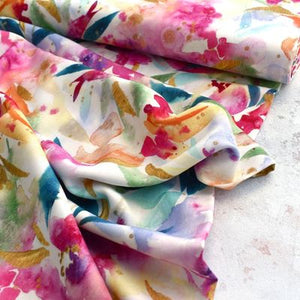A serger is exciting! It sews faster and finishes seams SO neatly, but the threading...and there are two needles...and differential feed...and four spools...and did we mention the threading? Sergers can definitely be one of the more intimidating pieces of sewing-related machinery you may come across, but we are here to give you some helpful tips to cut that tension (and maybe assist in finding the right tension on your serger, too!).
What Can (& Can’t!) It Do?
Sergers are fantastic for their speedy sewing of both knit and woven fabrics, with the added bonus of being able to skip a step by sewing and finishing knits all at once. Sergers (also called overlock machines) can also be helpful in merging fabrics of different types and weights together more easily than when using a sewing machine, create rolled hems, ruffles, sew elastic onto your project, and can even be used in quilting projects!
There a couple of tasks these magical machines cannot complete, such as topstitching, attaching zippers, and creating buttonholes, so don’t put your faithful sewing machine out to pasture just yet!

Tools, Tools, Tools
- Tweezers and a screwdriver should be part of the kit that you receive along with your serger. Aside from being handy when threading your serger, they also come into play when changing needles or detangling threads that may decide to go rogue!
- Keep some extra needles on hand just in case one breaks and to change every few projects. Be sure to check your manual to see the specific size and type of needles recommended for your serger.
- Serger pads and mats can be super helpful in keeping your machine’s noise level down as well as keeping it in place. Due to the speed at which they work, there can be quite a bit of vibration, and they get surprisingly loud, so mats can assist in making sure you’re not chasing your machine across the table or yelling at it to quiet down!
- Quality thread is something you’ve undoubtedly heard time and time again is important for sewing machines. It is also good to keep in mind for your serger due to the high speeds and abundance of lint. Polyester is great for all-purpose serging; Nylon or Wooly Nylon for elastic fabric like swimwear, and poly-wrapped/poly core is especially strong for some more heavy-duty fabrics. Cotton thread is NOT recommended because it lacks strength and tends to be very linty.
Sew Smart! Rather than purchasing four giant thread spools of a special color you want to match to your fabric, you can get a single spool of that color and use it in your left needle, along with a neutral shade for the other three spools.
Threading It (Yes You Can!)
Threading is by far the part of owning a serger that makes people groan out loud with dread, and though we admit that even we are unlikely to RSVP to a Serger Threading party, it won’t feel this daunting once you get the hang of it. Here are some tips:
- Many places will teach you the “pull-through” or knotting technique, making the whole process much quicker and easier. This is definitely valuable and a time-saver...BUT...
- Learn to thread your machine from scratch! Sometimes a knot opens when going through a tension disc or gets stuck, so you must know how to thread it from start to finish too. You can do this by watching videos and tutorials or referencing the diagrams on the inside cover of your machine or manual, and then practice, practice, practice!
- After you thread your machine, always take a folded scrap piece of the fabric you’ll be using and run it through the serger to be sure you are happy with the settings. Now is the time to find anything you might need to adjust, NOT on the garment you’ll be making!
Sew Smart! The upper looper of your machine uses the most thread, followed by the lower looper and then the two needles. You should occasionally switch the spools going into your loopers with those going into your needles so you can even out the rate at which the spools are used up!

Sharp Objects
- Knives—Your serger has two sharp blades to cut the fabric you are feeding into the machine and create even finished seams. These knives are sharp and should always be disengaged when sewing elastic (so it doesn't get cut!) and when threading or cleaning your serger.
- Pins—While sewing over pins is simply a bad habit when using a sewing machine, it becomes a hazardous situation when using a serger. The combination of the knives and the speed of the serger means a broken needle is inevitable and will likely ricochet much further than expected! Unless you particularly enjoy changing the needles of your serger and wearing safety goggles while sewing, here are some alternatives:
- Some fabrics like fleece are stable enough to sew without pins.
- Wonder Clips and basting sprays are also helpful ways of keeping fabric together without pins before passing it through your machine.
- If you must use pins, try to attach them to your fabric about 3” or so in from where you will be serging to avoid making contact with the knives.
Making Adjustments
- Differential Feed—This controls the speed of the two sets of feed dogs within the serger. The higher settings (2 is the highest) mean the front feed dogs move faster than the rear and are for stretchier fabrics to avoid having them stretch too much and get wavy. The lower settings (.75 being the lowest) mean the front feed dogs move slower than the rear and are best for thin or delicate fabrics to avoid having them pucker. At the normal setting (1), the front and rear feed dogs move at an identical rate.
- Tension Settings—This refers to the individual tension discs that each thread runs through. For most sergers, there is a comfortable “home” setting (very often “4”) that works for most fabrics. However, that does occasionally need to be adjusted depending on the thickness of your material.
- Stitch Length and Width—Similar to your sewing machine, these settings determine the length and width of your stitches and are adjusted by dials usually found on the side of your serger. Normal stitch length is usually 2.5-3, as it is on sewing machines, and stitch width can range quite a bit between sergers. Consult your manual for recommended settings.
Sew Smart! Once you figure out that perfect harmony of settings for the type or weight of fabric you are using, take a moment to write it down or snap a photo of it so that next time you can spend less time adjusting and more time sewing!

Tales of Thread Tails
Though you cannot backstitch on a serger, there are a few options for how to handle those pesky thread tails at the end of your serged lengths of fabric.
- You can serge the thread tail into the seam by simply serging a few stitches, lifting the presser foot, bringing the thread tail forward along the length of fabric about to be sewn, and lowering the presser foot back down before continuing, catching and securing the thread tail in the process.
- Sewers can also tie a knot in the thread tail close to the fabric and cut off the remaining threads.
- Or, our favorite method involves weaving the thread tail back into the seam with either a large-eyed needle or a serger seam hook.

Clean Up
Sergers are absolute lint monsters between the lint from four spools of thread to what comes off of the fabrics cut by its knives to create those lovely neat seams. Believe it or not, your serger needs to be cleaned more often than your sewing machine. Though we recommend having it professionally serviced annually, there are plenty of tools you can use at home on a regular basis to keep your machine running smoothly.
- Lint brushes—Your machine likely came with a brush for this purpose. There are also different size brushes you can get that may make the job easier.
- Microfiber cloths—Safe for cleaning for the larger areas of your machine.
- Tweezers—Can be helpful grabbing larger lint balls, scraps, and threads before getting into the nitty gritty smaller bits.
- Micro Vacuum Attachments—Sewers can purchase kits that have a variety of attachments for larger vacuums or even mini vacuums for use on tools, like sergers, for deeper cleaning.
Sew Smart! Never use canned air to clean your serger or sewing machines. They can push the lint and debris further into the crevices of your machine, and the propellants used in some brands can cause parts of your machine to snap or crack since they come out quite cold.
We SEW want to know what you think! What are some of the creative ways you’ve used your serger to add different elements to your garments or other projects?







Even though I’ve sewn with my rather old serger for years I learned a couple tips that will be very useful. Thanks!
Leave a comment